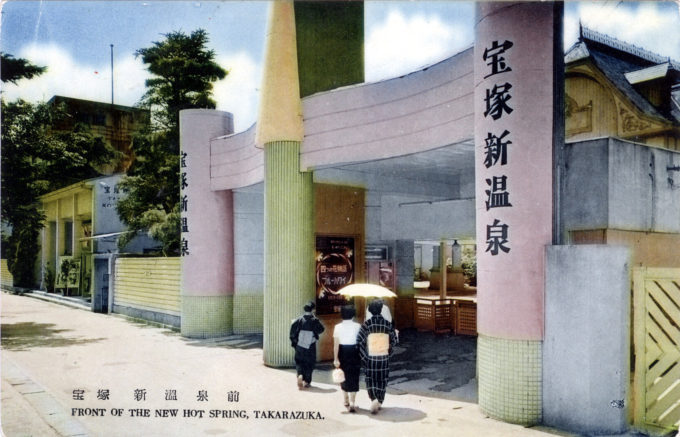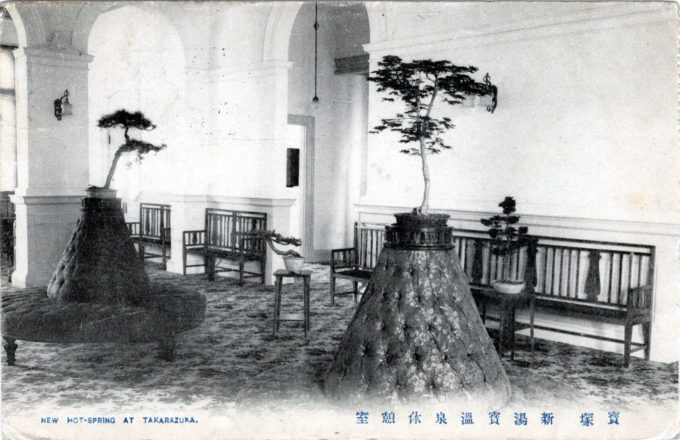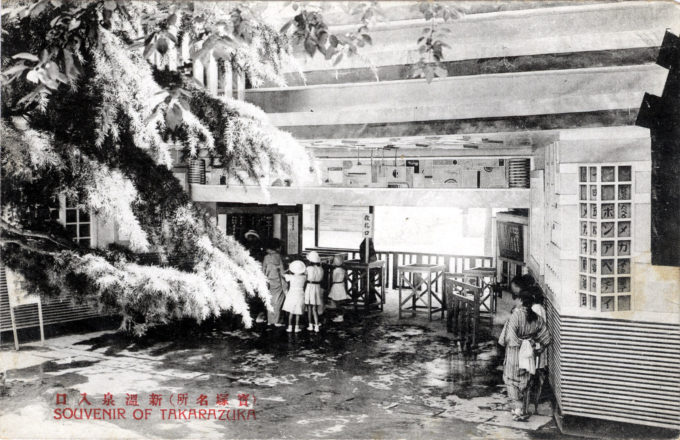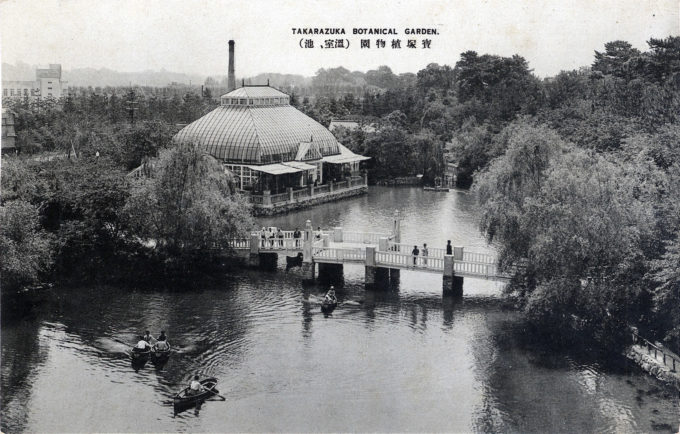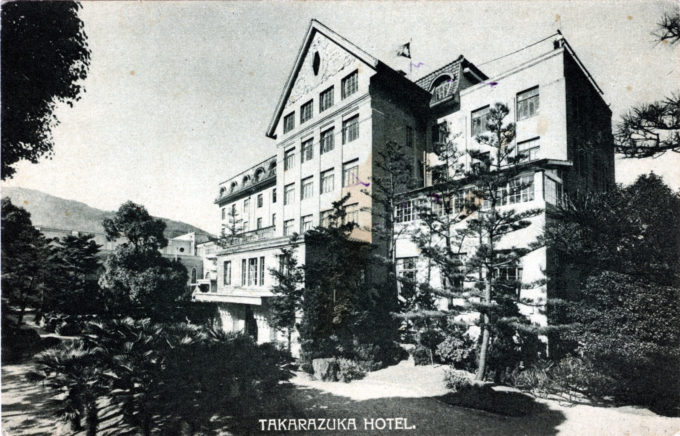
Takarazuka Hotel, Takarazuka, c. 1930. The 5-storey hotel opened in 1926. Developed by Ichizo Kobayashi, the founder of Hankyu Railway, the hotel was designed by architect Masaharu Furuzuka, one of the leading Modernist architects in the Osaka-Kobe area, who was hired to design a luxury hotel befitting a high-end tourist area. When new, the Takarazuka Hotel had an elevator, central heating, a private club and bar, and private hot springs baths. The hotel was built right in front of Takarazuka-Minamiguchi Station, which was opened by Hankyu Railway in 1921.
See also:
Takarazuka Gekijo (Theater), Tokyo
Takarazuka Revue, “Parisette”, c. 1930.
Aerial View of Yurakucho Theaters, c. 1935.
“Takarazuka, one of the most popular pleasure resorts in the district, is on a clear stream of the River Muko and is reached from Osaka or Kobe in 33 min. by the Hankyu Electric Railway. A motor-bus is also available, 43 min.
“The mineral spring, which has been known since 1546, is cool, but is heated for bathing. The great attraction of Takarazuka, however, is the Recreation and Opera House, containing three theaters, public and private baths, dining rooms, gymnasium, library, zoological and botanical gardens, and other features. The opera house is one of the largest of its kind in the world, having accommodations for 4,000 people. In it are performed musical renderings of Japanese and other fairy tales, foreign operas, etc., by a company of girl players [the Takarazuka Revue].
“The Takarazuka Hotel (54 rooms; room ¥4 up; breakfast a la carte, lunch ¥2, dinner ¥2.50), managed by the Hankyu Railway Co., a few minutes walk from the terminus, provides good accommodations for a week-end, and for amusements there are an 18-hole golf links of the Takarazuka Country Club, 1 m. from the hotel, and the Takarazuka Kaikan.”
– Japan: The Official Guide, Japanese Government Railways, 1941
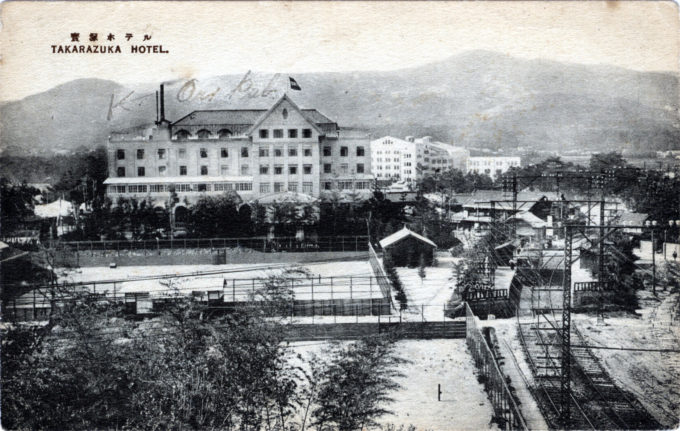
Takarazuka Hotel, Takarazuka, c. 1920, located at the terminus of the Hankyu Electric Railway’s Takarazuka Main Line from Osaka.
“Takarazuka is noted for its mineral springs which are efficacious in all kinds of diseases, especially in gout and rheumatism. The world famous ‘Tansan’, a good drinking water, is the principal product of this place. The place is situated along the Mukogawa. The celebrated temple called Kiyoshi Kojin stands on a hill 1 m. east of the station.”
– A Guide-Book for Tourists in Japan, Kihin Kai (Welcome Society), 1906
- Entrance to outdoor hot springs, Takarazuka, c. 1930.
- Lobby, Takarazuka Hot Spring in the Takarazuka Hotel, Takarazuka, c. 1920.
- Entrance to the zoological and botanical gardens, Takarazuka, c. 1930.
- Takarazuka Botanical Garden, Takarazuka, c. 1930.
“[Takarazuka] can be reached within one hour by electric car from Kobe. Being a clear and transparent carbonic-acid spring, it is very good for nervous problems, diseases of digestive organs, hysterics, etc.
“The resort consists of two sections. The new spring comprising a pleasure ground under the control of the Hanshin Electric Express Company, is run on a large scale. The bath-buildings and amusement hall occupy an area of about 2,000 tsubo, containing the Paradise, a Reception Hall, and a theatre.
“The old spring face the new one across the Muko River, and commands a very fine view of the neighbourhood. One mile further along the river brings one to the Wilkinson Tansan Spring. A well accommodated European style hotel is in the course of completion.”
– Glimpses of the East, Nippon Yusen Kaisha, Vol. 1926-1927
The Takarazuka Theatre/s
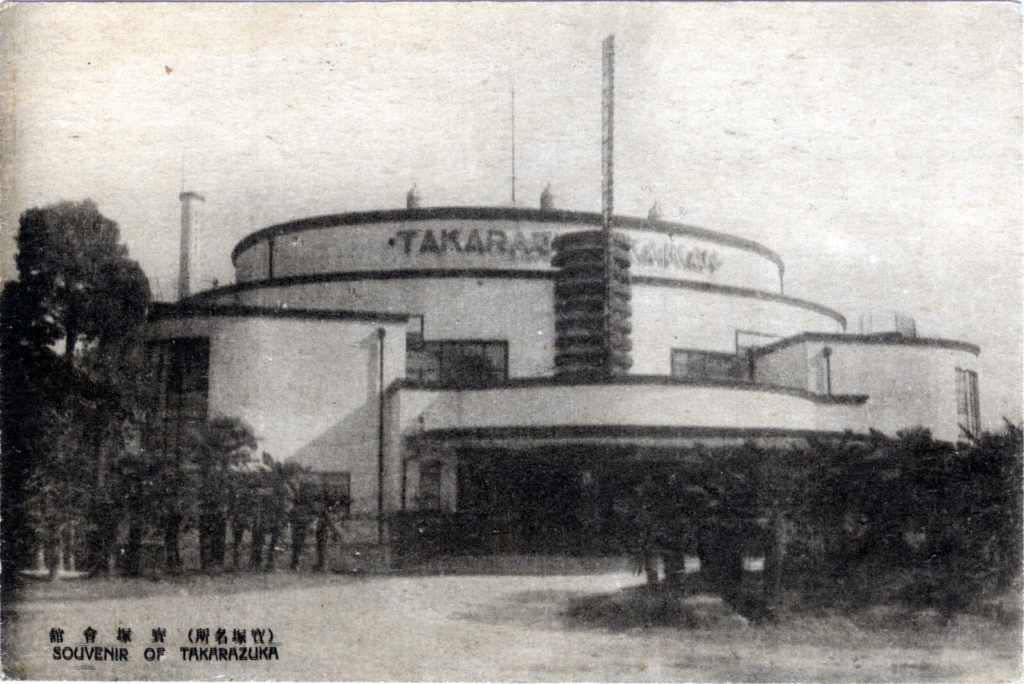
Takarazuka Paradise Theater, Takarazuka, c. 1924, that preceded the construction of the Grand Theatre in 1924. A provisional stage and audience seats, seating only a few hundred patrons, replaced an indoor pool that had turned out to be a poor investment.
“The Takarazuka Revue was one component of Kobayashi’s capitalist project to develop a mass theater that would facilitate the shaping of girls and women into seasoned consumers … For the first forty years of its existence, Takarazuka audiences were fairly evenly divided between females and males, although Kobayashi strategized ways of attracting women, and married women especially, to the nascent theater and amusement park.
“… In his efforts to capture the interest and loyalty of female customers, Kobayashi went so far as to lower the floors of Hankyu trains to make boarding and existing less awkward. He also staged a contest in which women nominated and voted on a color for Hankyu trains (‘Fujin muki no shinshiki densha‘ 1923). The winning color was the deep maroon that distinguishes the trains today.
“Apart from consolidating a female clientele, his motive was to nurture among theater-going women a bewitching stage presence of their own: ever woman could be a well-coifed star, so long as she shone on the home stage (‘Nippon gekijonai biyoin‘ 1937).”
– Takarazuka: Sexual Politics and Popular Culture in Modern Japan, by Jennifer Robertson, 1998
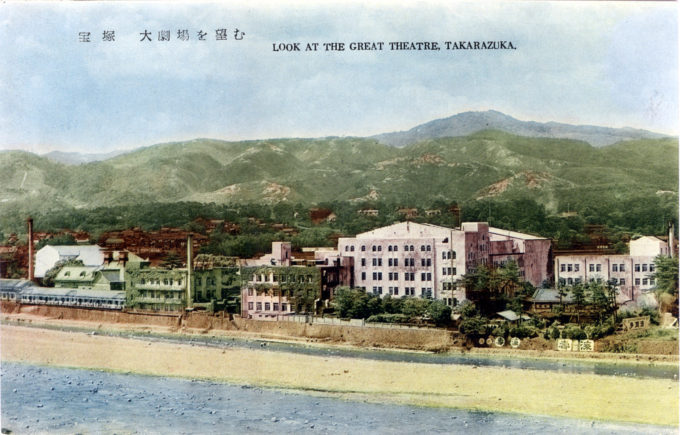
“Look at the Great Theatre,” Takarazuka riverfront, Takarazuka, c. 1930. Completed in 1924, the Grand Theatre was considered to be an impressive achievement, not only among Japanese theatres of that time, but also on a worldwide scale. It was designed to fit over four thousand spectators at a time when even the largest kabuki theatres in Japan seated, at most, a thousand. The architects-of-record for the Takarazuka Grand Theatre were Washio Kuro, who was in charge of the building design (and later the plans for Tokyo Takarazuka Theatre) and Fujii Yatarō, who prepared plans for the stage and audience.
“The Takarazuka Revue was among the modern theaters that marked the return of females to a major public stage after being banned from Kabuki performances in 1629 by the Confucian-oriented Tokugawa Shogunate.
“At the time the Revue was founded [in 1914], actresses (joyu) were still publicly denounced as ‘defiled women’ who led profligate lives. It seems that Kobayashi founded the Takarazuka Music Academy not only to train students in the Western and Japanese theatrical arts, but also to reassure parents that their daughters were under the constant supervision of academy officials whose responsibility it was to prevent the young women from falling into a decadent lifestyle.”
– Japanese Social Organization, by Takie Sugiyama Lebra, 1992


